Embarrassing busybodies
Channel 4's latest 'Mirror on the Industry' report is diversity-by-spreadsheet from a clueless, self-appointed authority. Advertisers should reject it out of hand.
Channel 4 has released its latest ‘Mirror on the Industry’ report, in which it purports to monitor the advertising industry’s performance when it comes to diversity and ‘representation’ in its output.
No one has ever asked Channel 4 to do this. Under its public service broadcasting remit, the channel has a requirement to promote diversity in its programming output and hiring practices, and has to report back to Ofcom every year. Psychologically, that’s probably a galling thing for its executives to have to do – most people like to think they’re doing the right thing because they’re good people, not because a superior is monitoring their every move.
So, like a toddler playing at being teacher, Channel 4 has chosen to cast itself as the superior to the people ‘below’ it in the food chain – in this case, the ad industry that largely funds the channel. On one level, it’s a useful way for Channel 4 to show Ofcom they’re going ‘above and beyond’ in their commitment to DEI. On another level, it’s a soothing displacement activity – a chance for the put-upon broadcaster to play the moral leader, instead of the obedient junior.
For this, the ad industry is supposed to be grateful. As the introduction to the report notes: “Ultimately, this insight initiative is Channel 4’s gift to the industry.” Yay, thanks!
Like all the best gifts, it comes with a snarky swipe at the recipient: “Mirror on the Industry launched in 2019 to see if the UK’s TV advertising was as inclusive as the industry said it was… spoiler alert, it wasn’t.” (Spoiler alert, this is because advertisers are horrid, whereas Channel 4 is great.)
We’ll come back to the corporate psychology behind all this. But this post is mainly about the report itself. For a mirror, it’s stunningly unreflective when it comes to its own blunderings and failings.
First, the buried lede. The headline finding reported in The Times and Daily Mail is one that the report quickly skips over. Despite continual talk of under-representation and a crisis of inclusion, it turns out that black people are now represented in 51% of ads, while making up 4% of the UK population.
A similar story plays out across other ethnic groups. According to members of the diversity commissariat, who have combed through 1,000 ads and pressed pause to assess the faces and skin tones, South Asians are represented in 17% of ads, while making up 8% of the population, East Asians in 11% of ads while making up 1% of the population, and ‘Mixed ethnicity’ in 9% of ads while making up 3% of the population.
Nowhere in the report does Channel 4 reflect on whether there might be a downside to this imbalance. Whatever the noble intentions behind it, the result is a world on screen that looks very different to the world off it – the kind of world that might make some feel alienated, or at the very least patronised. It can’t be framed as a necessary over-correction that will naturally settle to its ‘correct’ level – because, despite Channel 4’s earlier ‘spoiler alert’, the level of black representation was already 37% (compared to 3% of the population) in 2018, before Channel 4 took up the fight. Nor can there be grumblings that this is just token bit-part casting and doesn’t really count. According to the research, 23% of all ads feature black people in ‘lead roles’.
To be clear, I don’t lie awake worrying about the number of people of any ethnicity in ads. The trouble with critiquing this stuff is it reduces you to the level of those who treat humanity as a spreadsheet: tallying up which minority groups are represented, and how far those numbers deviate from census proportions, as this report does again and again. The underlying logic is that, once one group’s numbers are ‘solved’, attention moves to the next. And that’s exactly what happens in this report.
Pregnant people and over-70s, your time has come!
There’s no particular reason why Channel 4 has picked you out over the involuntarily childless, the over-80s, the widowed, the orphaned, the bald, the anosmic, the club-footed, the left-handed, maybe even the non-telegenic (we’ll come back to that). But for now, be grateful it’s your turn. Once we’ve got you over-represented, we’ll move on to the next group.
Assuming at least some of adland laps this stuff up, we can expect a wave of ads similar to the ‘essential example’ of Vodafone, who drew complaints from healthcare professionals over their depiction of a roadside birth facilitated by Vodafone’s excellent signal. And we can look forward to more ads in the ‘normalised’ mould of Durex briefly showing two older people getting frisky as part of its montage (no idea how we work out if they’re over 70).
I won’t dwell on the language of pregnant ‘people’ or the presumably pregnant trans man in the image above, though I’m sure others will take note. But it’s another sign of the intersectional aesthetic in which so many are invested. Wherever there’s a spreadsheet to be filled, someone who can tick many boxes in a split-second of screen time is invaluable.
Alongside the pregnant and the pensioners, disability also gets its turn in the spotlight. The report uses a baseline of 24% of UK adults having a disability (sourced from a government figure, though the claim there is that it’s 24% of all people, not just adults).
Either way, this is based on the broad definition of disability as self-reported impairments that have a substantial and long-term negative effect on someone’s ability to carry out normal daily activities. Only a fraction of those in that group will have a more obvious disability, such as being wheelchair-bound, severely sight-impaired or profoundly deaf. The majority will have less visible conditions, ranging from chronic depression to arthritis to dyslexia and ADHD.
The assumption of Channel 4 is that only 4% of ads feature such people, to which the obvious retort is – how the fuck do you know? It may sound glib, but in all seriousness – how do we know Gio Compario isn’t on the spectrum? How do we know Peter Kay’s ‘top bombing’ isn’t motivated by undiagnosed ADHD? How do we know Jack Dee isn’t staring at those penguins out of debilitating chronic fatigue syndrome?
The only way to ‘code’ such characters as disabled is to include an explicit reference to it in the script, which in turn invites cries of tokenism or negative portrayal. Channel 4 is the self-appointed authority when it comes to this stuff – deciding which ads are properly inclusive and which are “coded with tokenistic inclusion”.
Who are these mysterious diviners of what is inclusive and what isn’t? According to the report, it’s a consulting firm called Tapestry, within whose Clerkenwell walls “trained auditors review ads second by second, interpreting them as the average audience would, assessing both explicit and implicit cues to understand who is on screen and how they are portrayed.”
For my part, I have zero faith in the ability of a team of London EC1 diversity auditors to think remotely like the “average audience” would. And presumably they would find the concept of an “average audience” deeply troubling in any case.
But for these diversity experts, it’s not solely about setting aside the ethnic minorities in favour of the old, pregnant and disabled. Adland must also #DoBetter when it comes to the particular casting of ethnic minorities. This is where the report springs a masterful Kafka trap. On the one hand, you have to meet these absurd inclusion metrics in the space of a single ad, which is naturally going to lead to montage-style approaches that cram as many people as possible into your 30-second slot. (The report notes with zero self-awareness that these montage ads are now more widespread than ever.)
On the other hand, using montages is now deemed Problematic, because such an approach might be seen a shortcut or somehow tokenistic. (No shit – people have been rolling their eyes at this tokenism for years, and Channel 4 has encouraged it all the way.)
At the same time, the report insists that montage ads can still be the model to follow – you just have to do them the ‘right’ way.
Like this Virgin Atlantic ad, which the report elevates as the model for us all to follow.
Note that this advice comes from people who have never made an ad in their lives. I’ve laboriously taken the time to show exactly what their vision of ‘best practice’ advertising is – see my screenshots and commentary below.
Doing my best to respond as “the average audience would”, I think this ad stinks. It’s tiresome diversity drivel in which everyone looks like a catwalk model, white men are cast as high-flying executives, black men are happy bus drivers, Asian men serve up spicy food, and a ginger woman appears for a split-second looking genuinely bemused to be there – all in service of a commercially appropriated Maya Angelou script, which (with stunning creative originality) flogs holiday flights by showing happy people in exotic locations. Watch and learn, Bill Bernbach.
This is the future Channel 4 wants for advertising. There is zero curiosity about whether the ads are funny, entertaining, original, surprising, or commercially effective. Just make sure you get the right boxes ticked, but also do it the right way, and we’ll tell you afterwards which is which, because we have a team of diversity experts who think like average people do.
Bizarrely, the ad industry press is happy to go along with all this. While mainstream titles like The Times and the Daily Mail note the eye-opening over-representation of ethnic groups, the trade press contains zero mention of this and instead goes straight to the ‘more must be done’ narrative: Only 4% of ads include disabled people, says Campaign. Channel 4 report finds stagnation in DEI representation says Marketing Week. Channel 4’s Mirror on the Industry… highlights that progress is slow says Creative Brief. Channel 4 Report Exposes Representation Gap in UK Advertising says Little Black Book. None are allowed to mention any progress, let alone raise the uncomfortable issue of over-representation. The mono-narrative must be sustained.
Meanwhile, the rest of the world looks on in bemusement. I’ve written before about Jon Stewart’s brilliant evisceration of ad industry bullshit, which – in the name of busting stereotypes – has created a host of new ones: the omnipresent mixed-race couple, the perfectly balanced group of friends in the pub, the ethnically correct extras milling around diversely in every scene, the endless montage ads.
But we already know how Channel 4 responds to criticism of this stuff. “Complaints welcome!” it cheerfully advises the racists and bigots who are the only people who could ever possibly have an issue with it. “Ride me to Narnia, bitches!” is the cry from the newsreader who isn’t specific about which people he’s referring to as female dogs, but presumably it includes the Jon Stewarts of this world, who think most advertising these days is full of patronising dross that treats people as though they continually need to be educated out of their bigotry.
The report notes that it is landing at a time when the world is not showing the required progress. While taking care to lend an honorific capital to Disabled and Black people, the writers curiously stick to lower-case for the ‘reform supporters’ who are now ‘gaining visibility’. Presumably we’re just a few montage ads away from convincing Reform voters that they’re wrong about all this stuff and our diverse future will arrive as scheduled.
For its part, Channel 4 doesn’t stop at simply monitoring what is taking place in adland. It also actively intervenes to ‘encourage’ the right work with its Diversity in Advertising award. The name suggests it might be an award given to the best naturally-occurring DEI-friendly ad from the previous year. In fact, it’s a specific brief set in advance, to a theme decided by Channel 4’s diversity commissariat. The winner receives £1m in match-funded airtime, because horrible ad agencies would never do something vaguely good without a cash incentive.
So far, this scheme has brought us a nicely made film about an autistic schoolgirl’s family life, but one which crassly makes Vanish fabric conditioner the hero of the story, because it extends the life of the girl’s favourite hoodie. This is Channel 4 and adland’s version of social purpose – conceptually no different to Left-Handed Mango Chutney (a brilliant parody from 2022), and all executed with an obvious eye to awards schemes. Other winners include E45’s transgender ad, which does the same thing as Vaseline’s Transition Body Lotion and demonstrates capitalism’s admittedly brilliant ability to monetise any given social phenomenon.
I’m nearly done now, but first I’d better include the obligatory ‘to be sure’ paragraph, much as I resent having to write it.
To be sure, nothing in this post is arguing that diversity and representation should never be considered in the process of making an ad. And to be even surer, ads shouldn’t be exclusively full of straight white people. And to be absolutely even fucking surer, people who make ads should be mindful of the ‘tropes’ and shortcuts they will inevitably use when telling a story to a mass audience in 30 seconds. That is part of the skill of storytelling and mass communication.
But to be even surer, none of this is the goal or primary purpose of an ad, and it’s ridiculous to read every ad through this lens. The main goal is always to build fame and sell stuff in an entertaining and respectful way: that is the biggest service ads can perform for people of all races and backgrounds. Many of the greatest ads achieve this with zero diversity, because they feature zero people. Smash Martians, Cadbury’s Gorilla, Churchill the Dog, Sony balls, Honda cog, Compare the Meerkat. I genuinely wonder if some agencies now avoid such ads, because they offer no opportunity to demonstrate their diversity bona fides in the year-end report, or to please their comrades at Channel 4.
Which brings us back to Channel 4 itself – this self-appointed authority whose board is currently 12 white to 1 black, and 8 male to 5 female. (To be fair, I have no idea what hidden disabilities any of them have, or their sexuality, or their class background, or their physical health, or their religion, or their life experiences and traumas, because that important stuff doesn’t show up in photos.)
This is the Channel 4 whose recent content includes Embarrassing Bodies (in which taboos are busted by gawping at naked people), Virgin Island (in which taboos are busted by sending young virgins to a Croatian island), Open House: The Great Sex Experiment (in which couples are pressured into open relationships, one of them reportedly vomiting in humiliation at the experience), Naked Education (in which adults strip naked in front of school children), and 1000 Men and Me (in which Bonnie Blue does what it says in the title – advertisers actually withdrew their ads from that one).
Despite this noble record, Channel 4 has been haemorrhaging younger viewers to Twitch and YouTube, and one of its former commissioners recently wrote an article in which he identifies the source of the problem: it’s the viewers.
According to the article, “It’s viewers who are scared of trying new talent, not commissioners. It’s viewers who nine times out of ten will choose a mediocre true crime or celebrity doc over a brilliantly made doc about almost anything else. It’s viewers who – overwhelmed with choice – are terrified to take risks on unfamiliar-looking new propositions.”
At least Channel 4 is consistent in this. If you complain, it’s ‘Ride me to Narnia, bitches’. If you stop watching, it’s because you’re a villain who’s scared of brave content.
And if you stop advertising? Well, we may eventually find out. Channel 4’s traditional ad revenue is in long-term decline and talk of privatisation flares up periodically. At some point, its uncomfortable straddling of public-service remit and commercial pressures may become impossible to sustain, especially if it’s obsessed with relentlessly diversity-monitoring the hand that feeds it.
Returning to the corporate psychology with which this post started, it’s the power dynamics that are most fascinating in all this. At the top, you have the Government and Ofcom, which has ratcheted up the DEI requirements on Channel 4 to the point where they go far beyond the relatively broad terms with which it started in 1982.
Then you have Channel 4, meekly answerable to its Ofcom overlords, but compensating by coming home and kicking the cat – i.e. its advertisers.
By Channel 4’s framing, they are the ones who genuinely care about diversity and inclusion. It’s nothing to do with it being a statutory requirement – they just live and breathe this stuff.
But advertisers are the grubby little bastards who only care about commercial results. So Channel 4 helpfully wheels out the inevitable ‘business case’ for doing the progressive thing. All of it is familiar over-claiming based on sketchy research by the Unstereotype Alliance, another interest group that goes in search of evidence for the arguments it already believes.
Then you have the advertisers who duly turn around and preach to the people below them in the food chain – the poor bastards who have to watch this stuff. In the end, it’s the viewers who bear the brunt of this box-ticking, and they’ve all noticed ads are crapper than they’ve ever been.
‘But the viewers want this!’ insists the report, having asked the usual leading questions to its survey respondents. (Effectively, ‘Do you think it’s important for ads to be inclusive or are you a bastard?’)
What irks me most about all this is that it’s the critics (like me) who risk being labelled bastards and bigots. Channel 4 and its acolytes have no conception that the criticism might be rooted in something else entirely: an actual respect for other people’s basic human decency, which I believe is widespread, even among the dreaded working classes.
Like many people, I don’t see the public as racist, sexist bigots who need to be coaxed out of their prejudices by sufficiently progressive casting decisions from the corporate brands flogging them holidays and phone contracts during the ad breaks. I think the vast majority are on board with the broad ideas of diversity and inclusion, which have deeply liberal, humanistic roots. But they’re turned off by the co-option of those values by a DEI professional class that relentlessly raises the salience of identity categories in a way that increases division, while creating the kind of cultural background noise that favours whatever elements of the far right exist and want to take advantage of it.
I think Channel 4 is profoundly clueless when it comes to diversity in advertising, and all of its efforts are self-centring and counter-productive. Even if you insist on judging an advertiser’s output by a crude headcount, you can at least do it over the course of five years of content across all media, rather than expecting a single TV ad to cover it.
But the report ignores all this grown-up stuff and stands there like a toddler with a clipboard, shouting at the assembled class. If advertisers have any respect for themselves and the public, they should ignore this bullshit and work from the assumption that most people don’t need re-educating by consumer brands and their carefully audited tropes. Make great ads, place them wherever works best, and let Channel 4 be grateful for whatever it gets.
For anyone new here, I am this guy and this is my book.
Anyone who enjoyed this post might also like: My inherently problematic Christmas ad diversity audit

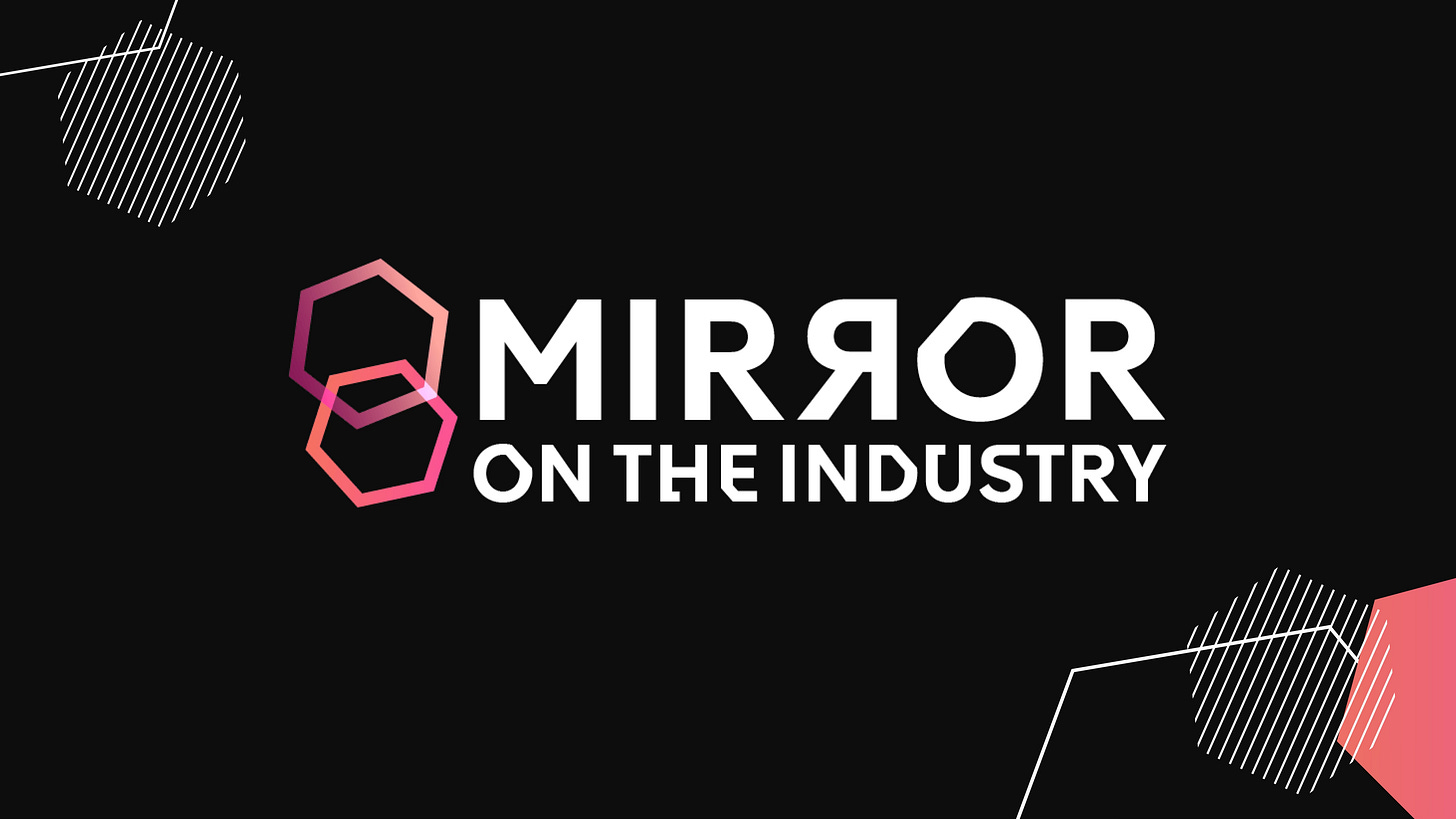
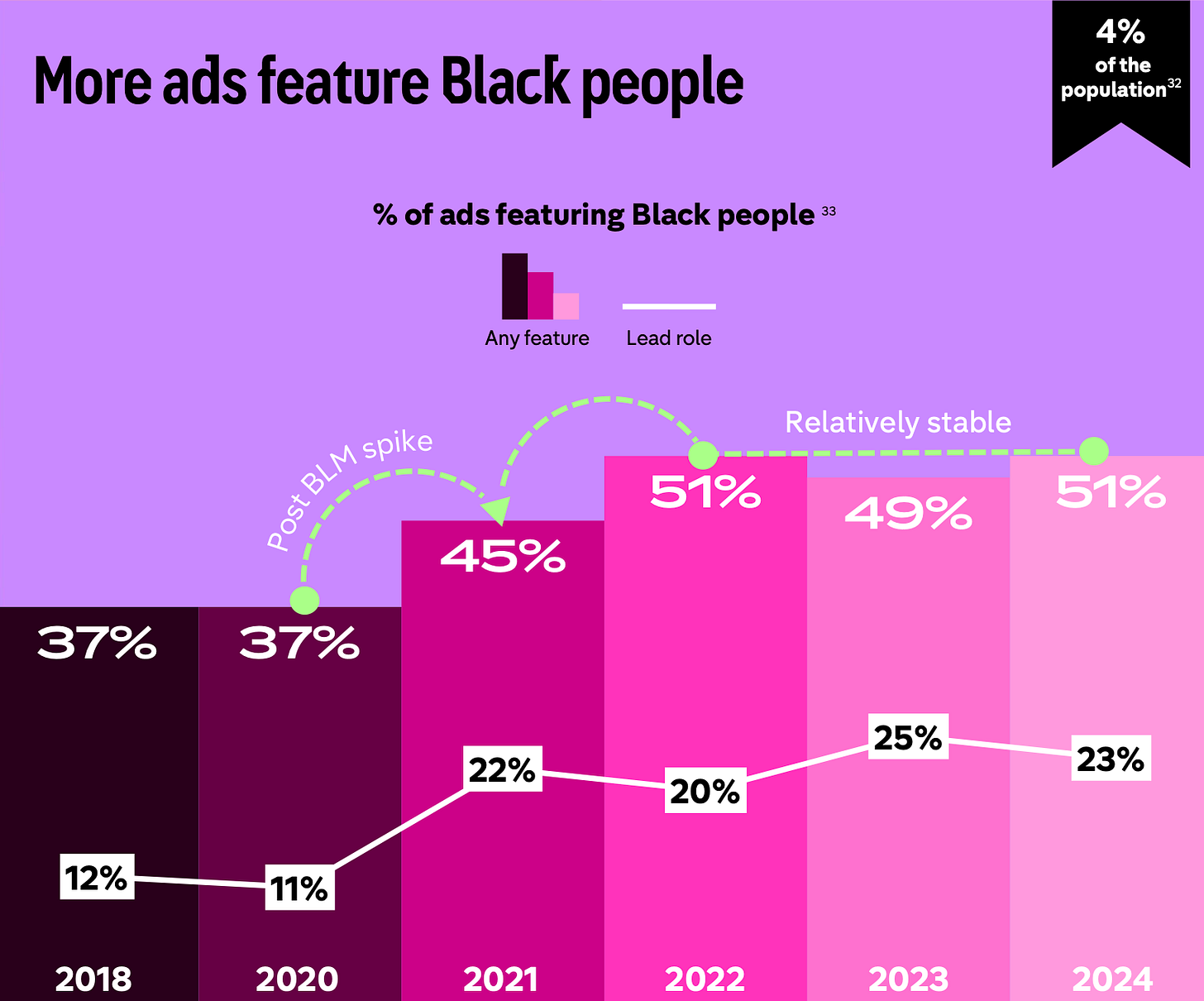
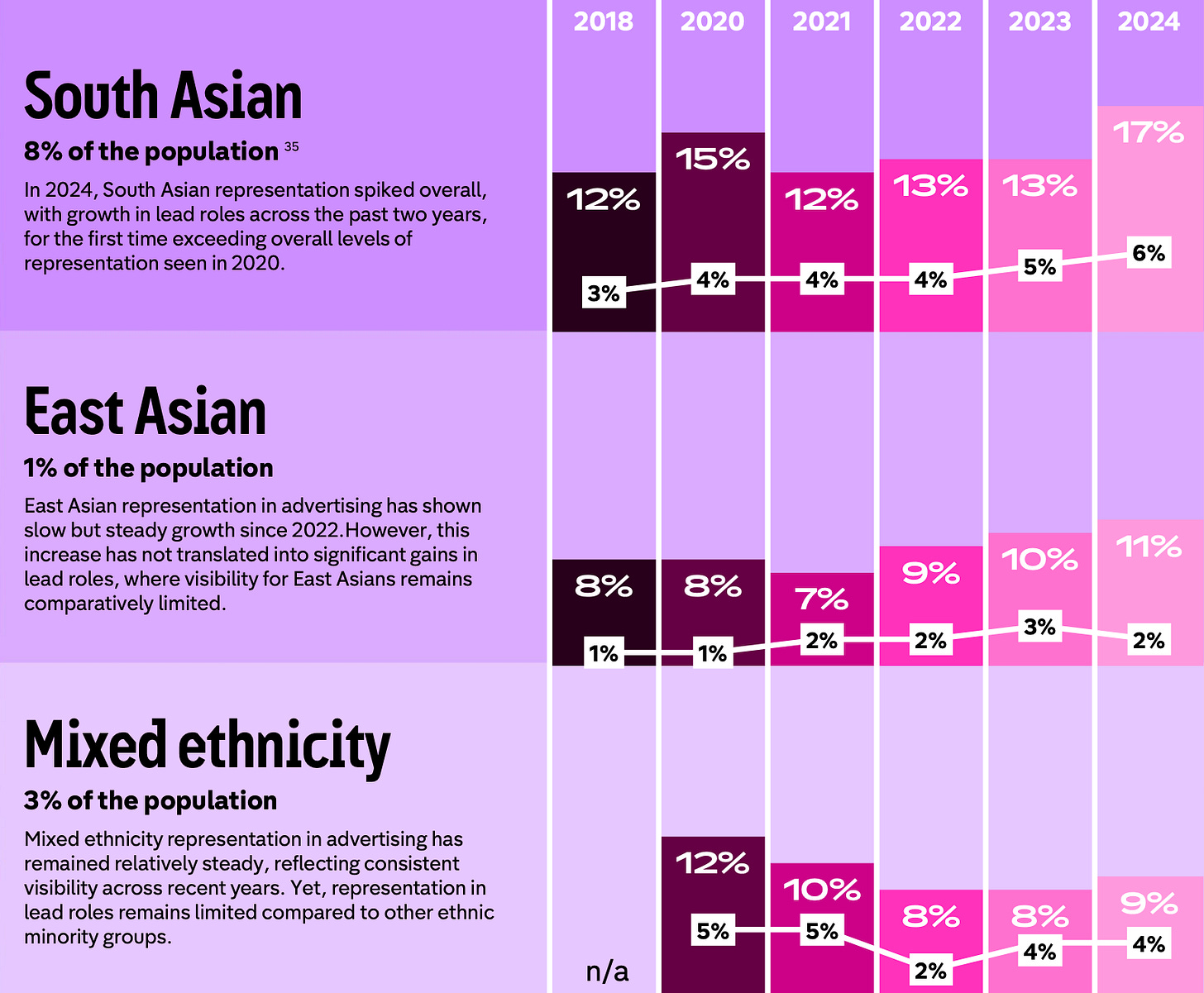
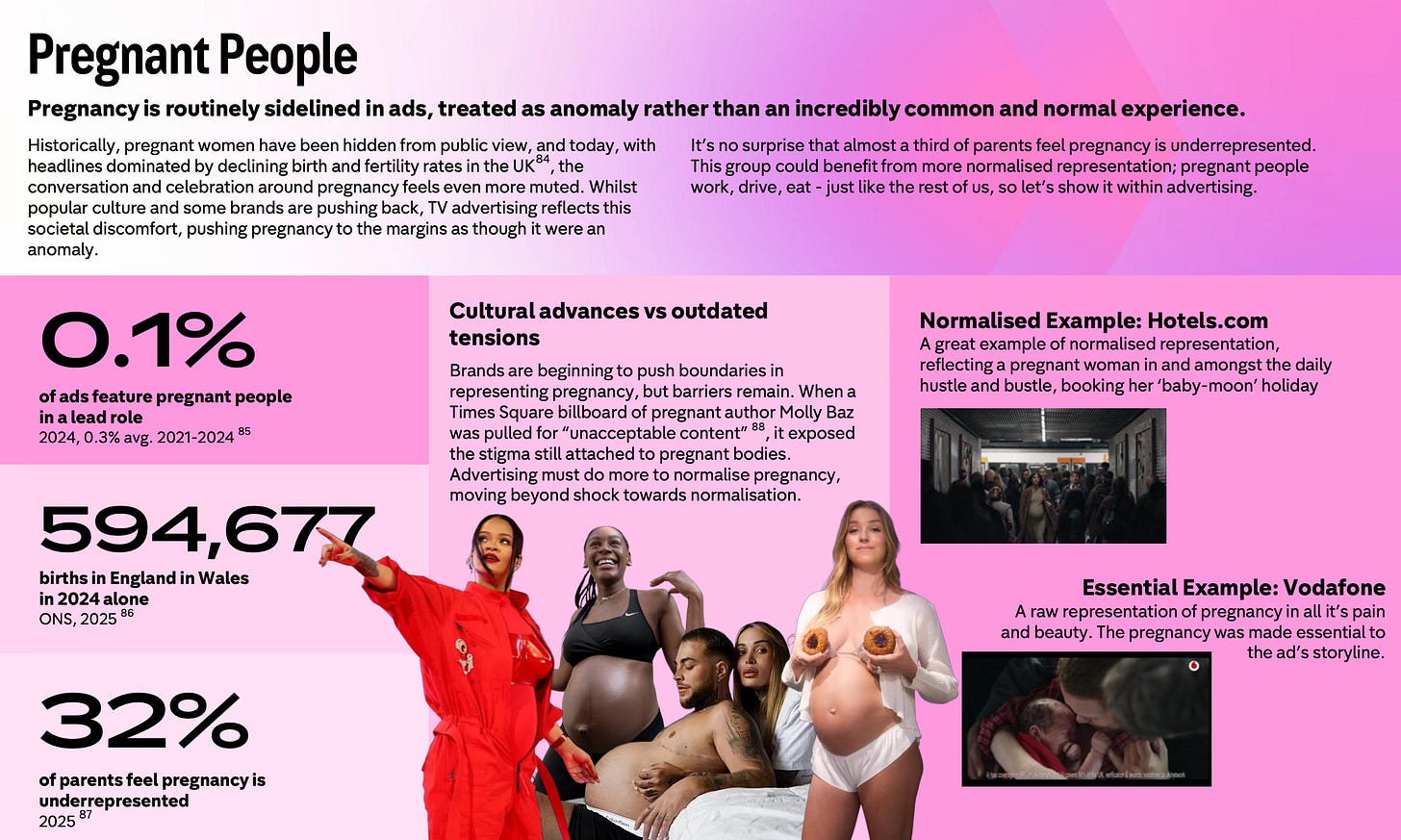
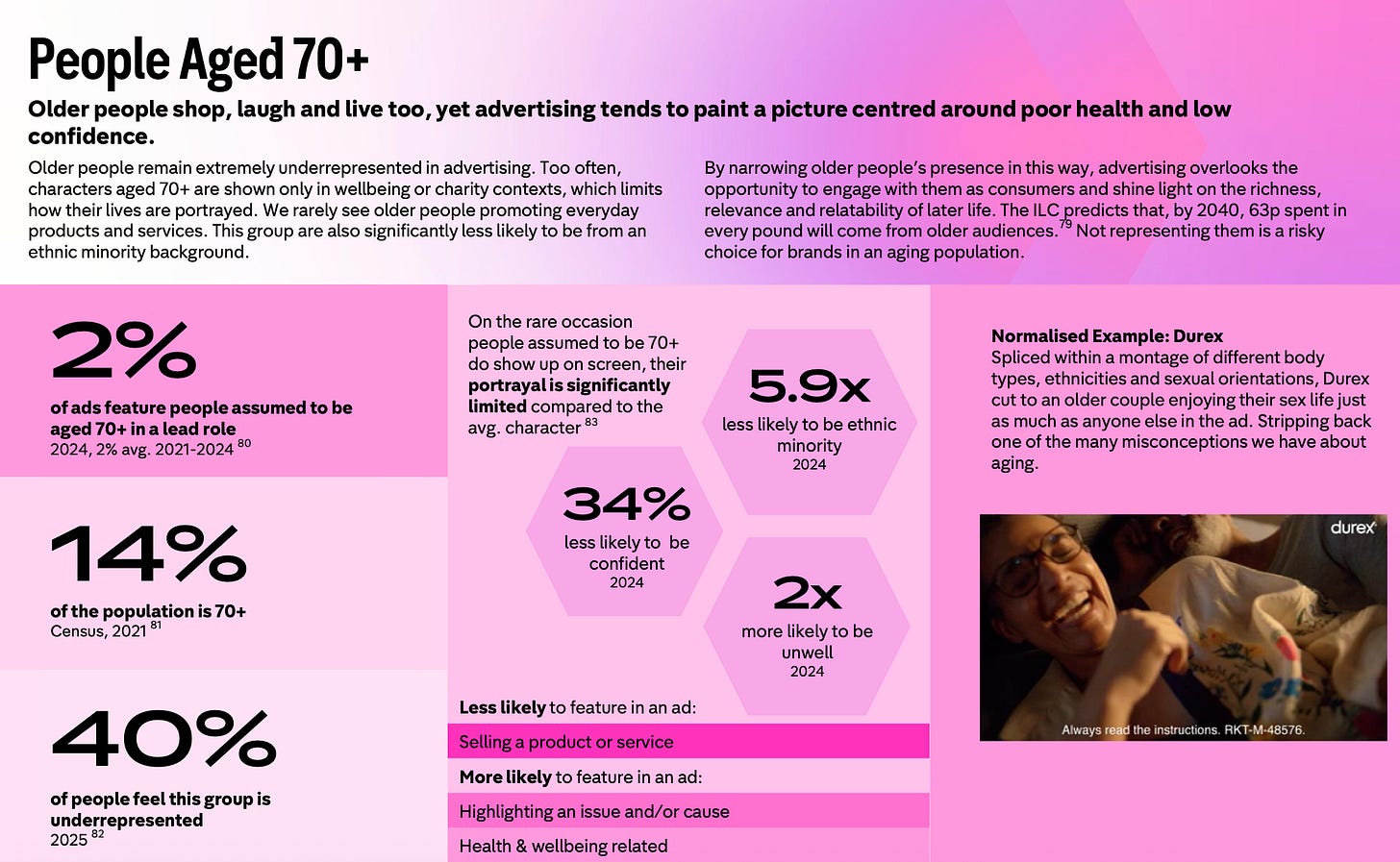
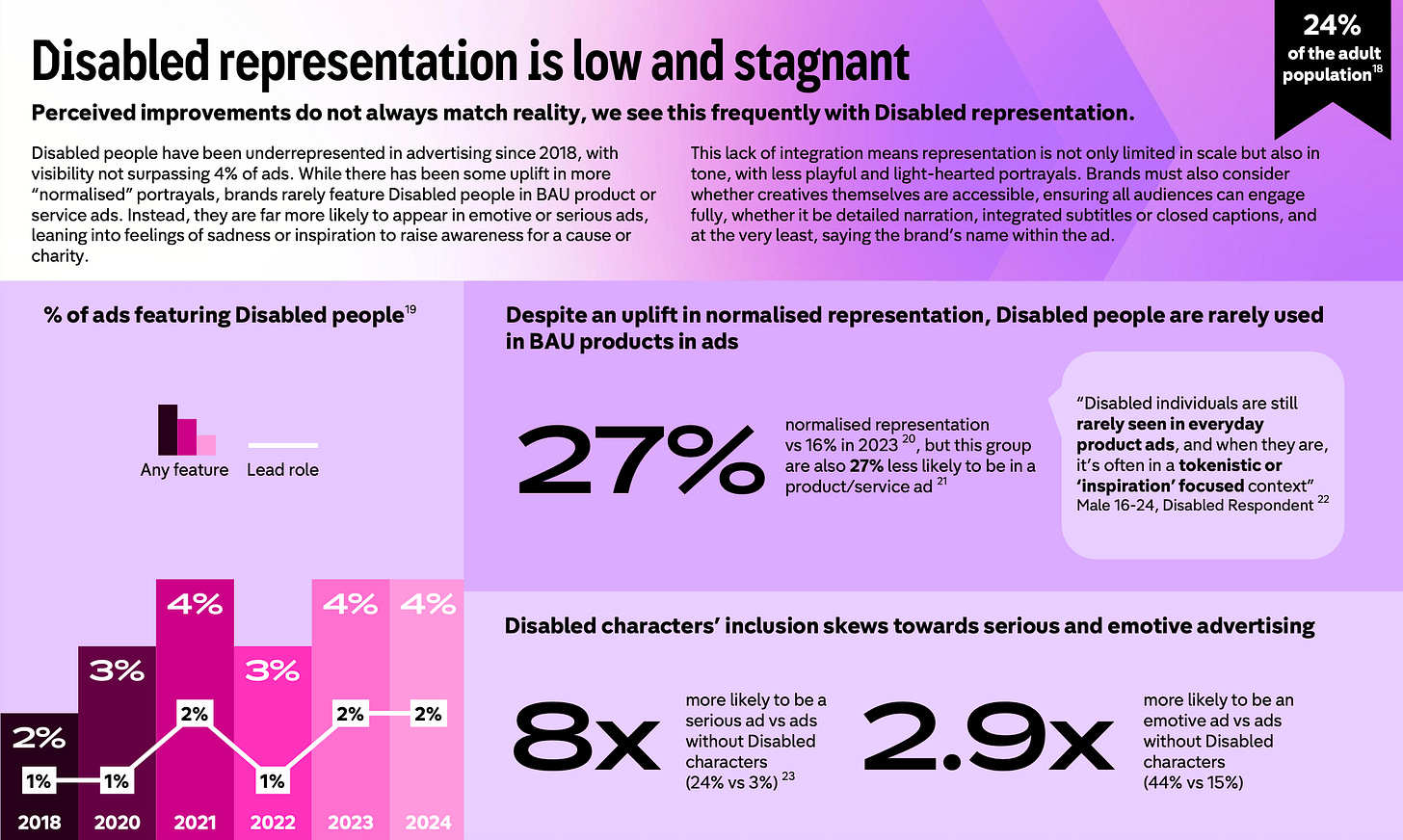

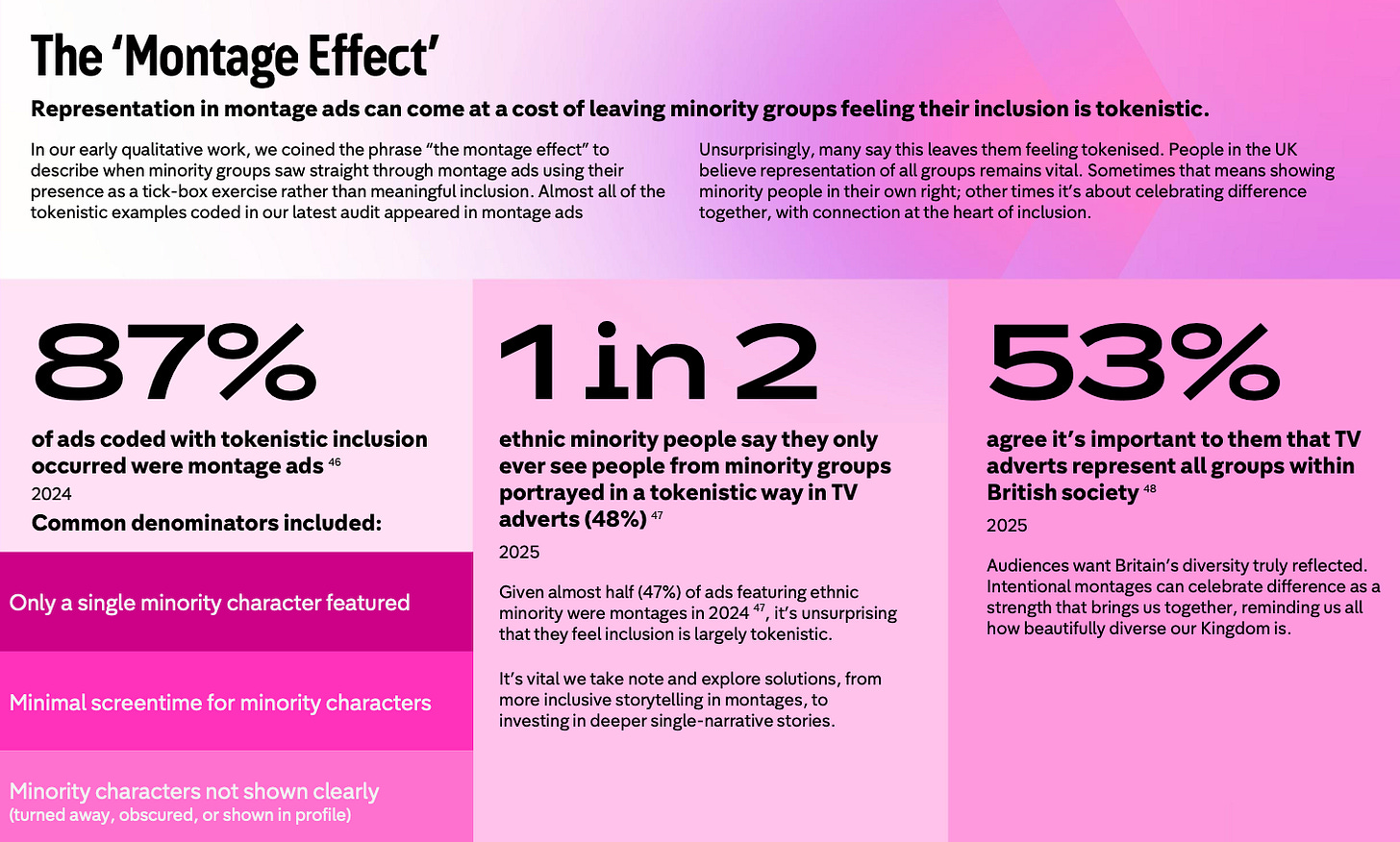



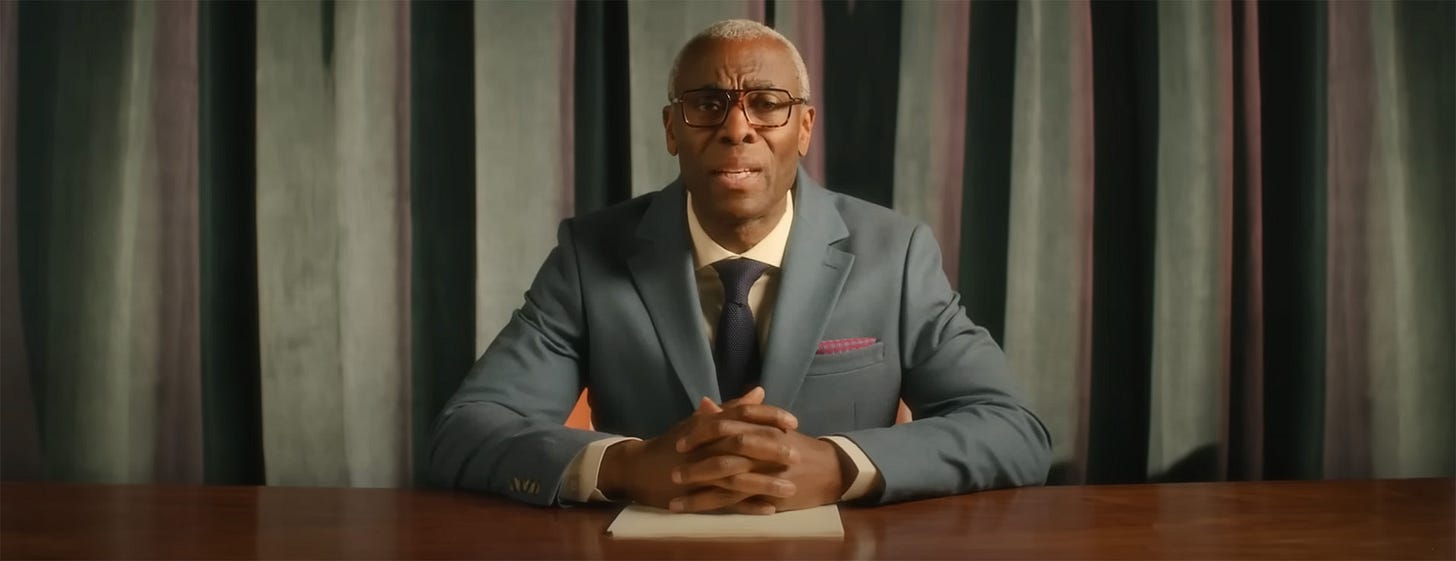
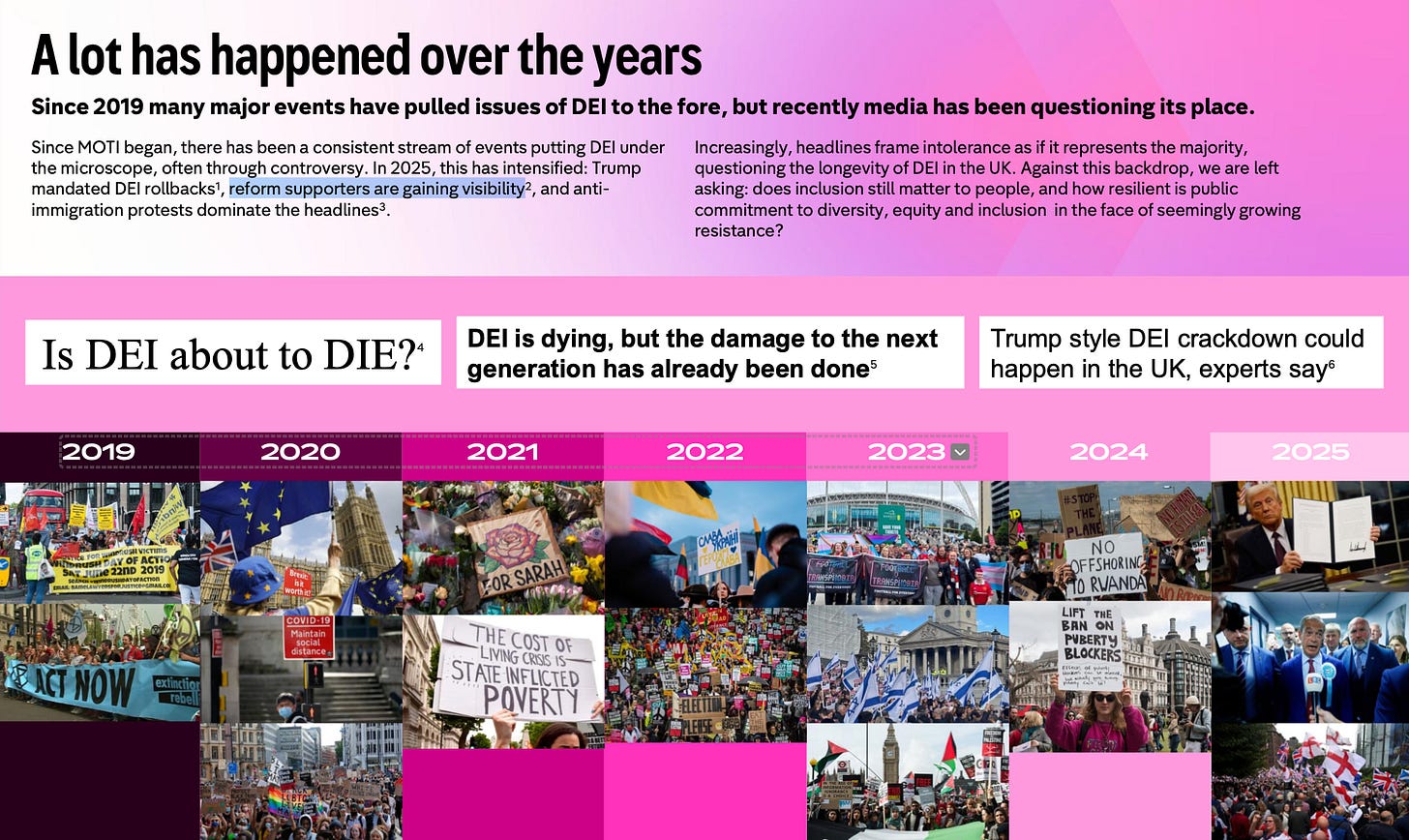
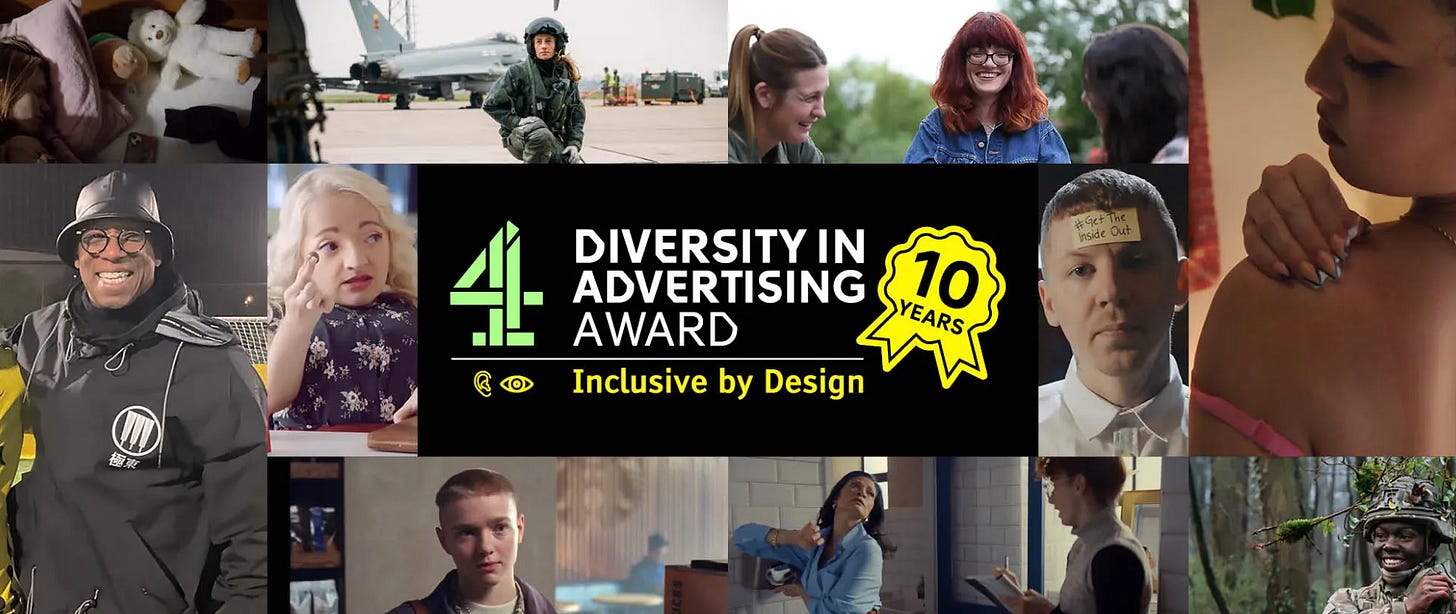



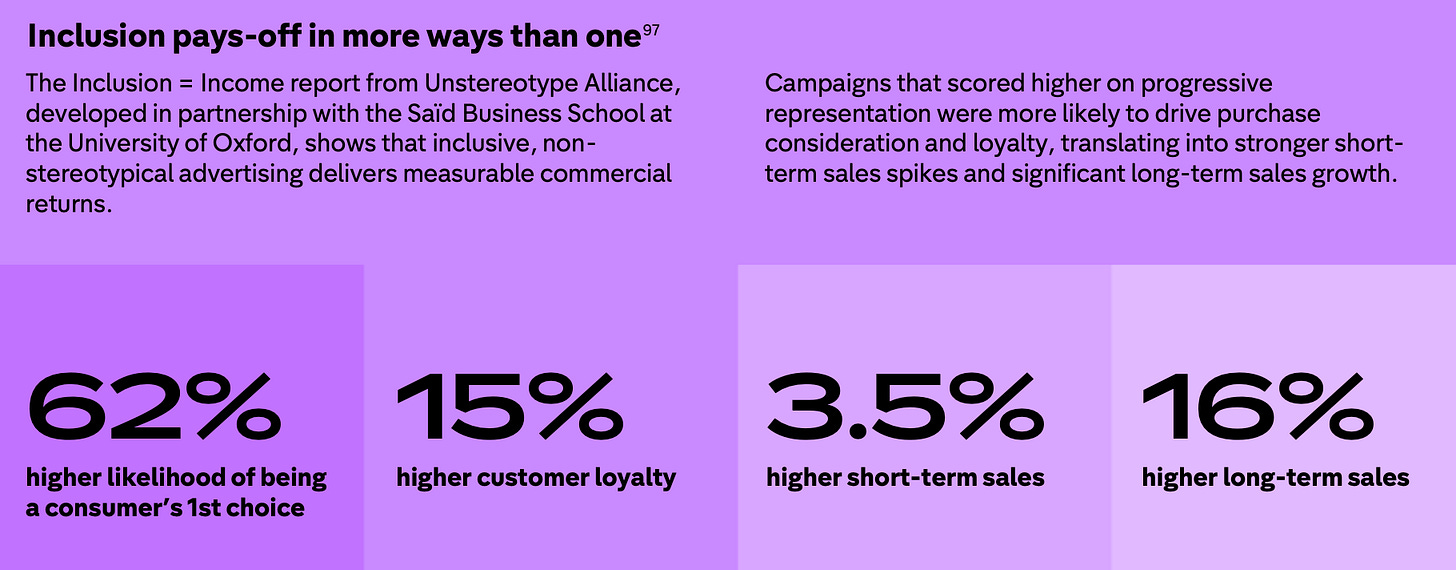
I liked and unliked this just so I could like it again.
You can see how the wild over representation happens though. It is pointed out to advertisers that a group is underrepresented. But advertisers aren’t pooling their data on how diverse their ads are; they’re independent and so they overcorrect like mad, and so you get a runaway effect. But once that’s in place, it’s very hard to be the advertiser who says “ummm, why have we cast this as mixed race?” because you might (almost surely will) get dinged by people who CARE about this. (Such as Channel 4, but also Bluesky.). So there’s a sort of deadly embrace or Reverse Prisoner’s Dilemma where nobody can defect because they’ll lose.